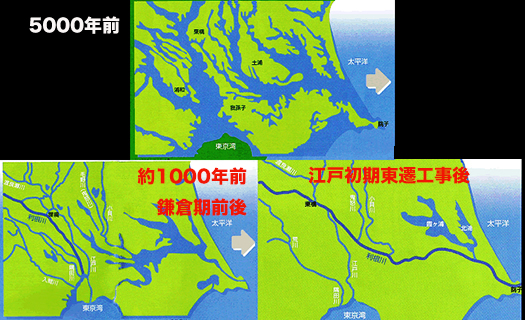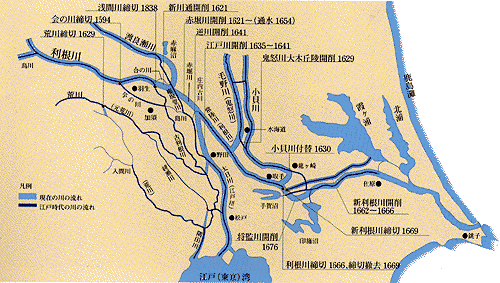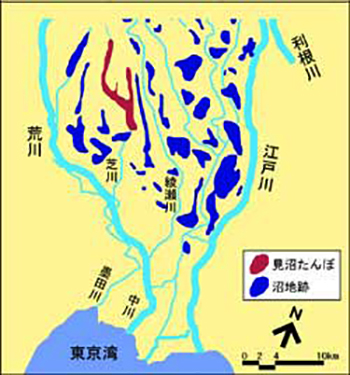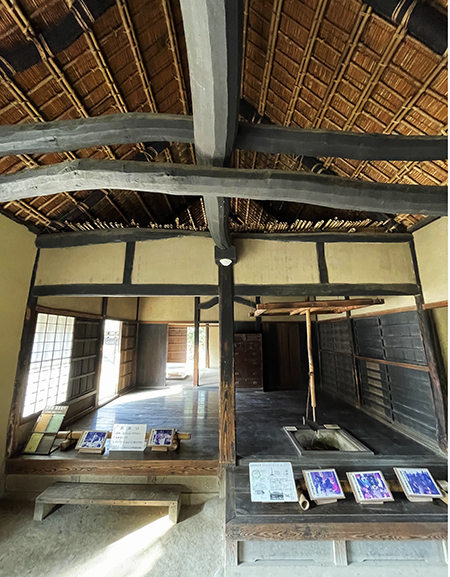

きのう家康による「利根川東遷」という関東開発の大土木公共事業について触れた。家康が信長と同盟関係を結ぶ時のエピソードとして信長が常識的に京大阪という中心地域、畿内方面に勢力を拡張する方針を示したのに対して、家康は武家勢力の伝統的志向として東国方面に向かっての勢力拡張を目指したと言われている。
当時の織田徳川関係での平和共存、同盟としては当然の方針だったと思うけれど、ある意味ホンネでもあった可能性がある。信長後継の秀吉政権として家康に関東移転を命じたときに従順に従ったのには、そういう要素が色濃くあったのではないかと推測できる。
「あんた関東好きなんでしょ?」「上様、その通りでござる」
領国経営という意味では、基本的な生産力を上げることが自分の勢力拡大の最大の機会。家康はそういう方面のテクノラートを積極的に引き立てている。この利根川東遷計画に伴う土地開発計画でこの大土木工事には代官頭・伊奈備前守忠次を始めとする伊奈一族が伝世、中心的な存在として任用され続けた。事業の継続性には江戸政権の命運も掛かっていたと思える。やがて利根川の東遷から、荒川の西遷という土木事業をも誘発して関東中部地域の地盤安定・新田開発などの事業が伸展していった。
歴史事実としてはどうしても政戦のことが主に注目されるけれど、派手な政治軍事の底流ではこうした地道な自然改造努力が支えていた側面が大きい。家康という人物からはこういった目配りに繊細な感覚が見える。


一般社団法人 東京建設業協会のHPに「江戸幕府 60年かけ瀬替え、開削の大規模治水事業」という記事があって詳細な記述が見られます。この公共事業が江戸の新都市開発にとっていかにキモであり、その事業の成功が現代に至る首都機能の中核になっていることがわかる。
そしてその大計画は長い時間を掛けて継続され、1700年代初期に至ってこの家の周辺、浦和近辺での新田開発「蓮見新田」を造営してそれを見下ろす舌状台地上に、この事業主体者として旧蓮見家は建設された。茅葺き寄棟造りで、さいたま市内で一番古い民家と考えられている。
去年より今年、そして来年はもっと広げたいと新田開発の様子を毎日確認しながら、農作業・土木作業に取り組んでいたに違いない。新田開発に必至で取り組んでいた1700年代前期の開発農家の暮らしようが伝わってくる
はるかな後世の現代人は関東地域というと基盤整備の進んだ以降の姿しか知らないけれど、北海道で言えばつい150年ほど前の最初期の開拓農家とも似通った空気感が漂っていることになる。そう考えると高々100年程度の時間相違しかない。日本史の身近さ。その当時から歳月の積層による空間の変化はあるだろうけれど、建物の端々にその当時の人びとの息づかいは残されている。
歴史の時間の掘り起こしと住宅の取材とが絡み合って、独特のよろこびを感じることができる。最近見た間宮林蔵さんの生家にも似た雰囲気とも言えるだろうか。
English version⬇
Development of New Rice Fields Parallel to the Construction of the Edo Capital: Development Farmers in Urawa-2
Major civil engineering work in Kanto is the fundamental stable foundation for the establishment of the Edo shogunate. A major civil engineering project to create an economic foundation to replace war civil engineering. The foundation of Ieyasu’s success. ・・・・.
Yesterday, I mentioned Ieyasu’s “Tone River eastward shift”, a major public engineering project for the development of the Kanto region. It is said that when Ieyasu formed an alliance with Nobunaga, Nobunaga’s policy was to expand his power in the central region of Kyoto-Osaka and the Kinai region, whereas Ieyasu’s policy was to expand his power toward the eastern part of the country, which was the traditional orientation of samurai power.
This was a natural policy for the peaceful coexistence and alliance between Oda and Tokugawa at that time, but it is possible that Ieyasu was also sincere in a sense. When Hideyoshi, the successor to Nobunaga, ordered Ieyasu to relocate to the Kanto region, I suspect that there was a strong element of this in Ieyasu’s obedience to the order.
You love Kanto, don’t you? “You are right, my liege, that I do.
In terms of managing a fiefdom, the greatest opportunity to expand one’s power is to increase the basic productive capacity. Ieyasu is actively promoting technorats in that direction. The Ina family, including Ina Bizen no Tadatsugu, the head deputy magistrate, continued to be appointed as a central figure in this major land development project for the Tone River eastward shift project. It seems that the fate of the Edo administration also depended on the continuity of the project. Eventually, the eastward shift of the Tone River triggered the westward shift of the Arakawa River, which led to civil engineering projects to stabilize the ground in the central Kanto region and to the development of new rice paddies.
Although the political battles are the main focus of historical attention, the underlying political and military activities were largely supported by these steady efforts to improve the nature of the region. Ieyasu shows a delicate sense of attentiveness to such matters.
The Tokyo Construction Contractors Association website has an article “Edo Shogunate Spent 60 Years Replacing Segai and Opening the Sea for Major Flood Control Projects” with a detailed description. The article, “The Edo Shogunate Spent 60 Years Changing Segae and Opening the Sea,” provides a detailed description. It shows how this public works project was the key to the development of the new city of Edo, and how the success of the project has become the core of the capital’s functions to the present day.
The great plan was continued over a long period of time, and by the early 1700s, the old Hasumi House was built on a tongue-and-groove plateau overlooking the new rice paddy development “Hasumi Shinden” in the vicinity of this house, Urawa, as the main entity of this project. The house is a thatched hipped roof structure and is considered the oldest private house in Saitama City.
They must have been engaged in farming and civil engineering work, checking daily on the development of new rice paddies, hoping to expand the area this year and next year more than last. This photo conveys the way of life of farmers in the early 1700s, when they were working hard to develop new rice paddies.
Although people of today’s generation only know of the Kanto region as it has appeared since the development of the infrastructure, the atmosphere in Hokkaido is similar to that of the earliest pioneer farmers of Hokkaido, only 150 years ago. In that sense, the difference in time is only about 100 years at most. The familiarity of Japanese history. Although the space may have changed over the years, the buildings still retain the breath of the people of that time.
The intertwining of the excavation of historical time and the coverage of the houses gives me a unique sense of pleasure. The atmosphere is similar to that of Ino Tadataka’s birthplace, which I saw recently.
Posted on 7月 20th, 2023 by 三木 奎吾
Filed under: 住宅マーケティング, 日本社会・文化研究







コメントを投稿
「※誹謗中傷や、悪意のある書き込み、営利目的などのコメントを防ぐために、投稿された全てのコメントは一時的に保留されますのでご了承ください。」
You must be logged in to post a comment.